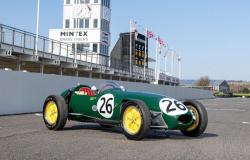The 128 model, whose launch on March 29, 1969 was accompanied by massive television and radio advertising, offered a front-mounted transverse engine driving the front wheels. And this at a time when most of the competition still insisted on the classic concept with the engine in the front and the rear axle drive.
Chief engineer Dante Giacosa was responsible for the development of the “one hundred and twenty-eight”, which replaced the slightly outdated Fiat 1100 in the production program, and the designer of its drive unit, Aurelio Lampredi, also played a significant role. The brand new 11-stroke with a timing belt-driven OHC distribution received an aluminum head or valve clearance adjustment with shims. Thanks to the transverse engine placement, the Fiat 128 was also one of the first mass-produced cars to have an electrically driven radiator fan.
Although the Italians were not the first to come up with the “everything at the front” solution – the Citröen Traction Avant was already being produced between the wars – nor the mounting of the engine with the gearbox at the front across – a similar solution was used ten years earlier by Alec Issigonis for his Mini – but with the Fiat 128 the designers from Turin managed to bring this concept to near perfection. The new fiat was nimble compared to the competition, and thanks to the lack of a shaft tunnel, it also offered relatively generous interior space despite its compact dimensions.
Giacosa, who became famous for his work on the Fiat 600 and 500, was able to draw on the experience that the Italian concern gathered at sister brand Autobianchi when designing the 128. It had been producing the small Primula since 1963, on which the Turin automaker tried out both the transversely located engine with the attached gearbox and the related drive shafts of various lengths. At the same time, the small sedan was extremely successful, in 1965 it came in second place in the European Car of the Year poll.
In 1970, however, the Fiat 128 fared even better, which was declared the best car of the year by European motoring journalists. The Autobianchi A112 (a smaller “cousin” from the Italian concern, using the same technology) finished second at the time, and the third place belonged to the Renault 12, which became the prototype for the long-lived Romanian Dacia 1300. But a long career awaited even the “one hundred and twenty-eighth” and it, too, next to his native Italy contributed to the motorization of a number of other countries not only in Europe, but also in America and Africa.
In Italy, the Fiat 128 of the first generation, according to contemporary advertising, the car that even the famous Enzo Ferrari used for private drives, was produced until 1976. After that, a modernized version came on the market, which was distinguished by, for example, angular lights, plastic bumpers and a dashboard. In addition to the four-door sedan, the three-door Familiare station wagon (after Panorama modernization) or the two-door Rally version were also produced. In addition to the eleven-cylinder engine, a larger engine with a volume of 1290 cubic meters appeared under the hood.
The technology from the 128 model also appeared in a pair of successful sports cars. The first, with a more conservative appearance, was called the Fiat 128 Coupé (later it received a folding rear and the name Fiat 128 3P). The engine and other mechanical parts were also used by the exotic-looking Fiat X1/9 with an engine located in the middle, which was produced in the Fiat and later Bertone factories until 1989. The original 128 thus survived the successful sports car in the United States by six years.
An even longer career awaited the Fiat 128 and derived models in South America or Yugoslavia, respectively Serbia. In Argentina, where a five-door station wagon unknown even in Europe was created, they stopped production at the beginning of the 90s. The Serbian factory Zastava produced the five-door hatchback, introduced in 1971, until 2008. In addition, the Serbians also produced a smaller number of the sedan version, which they exported for assembly in Egypt until the end of production of the model with a folding rear.







